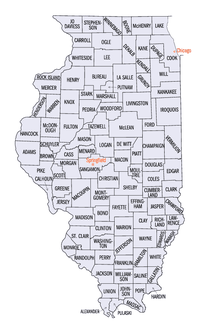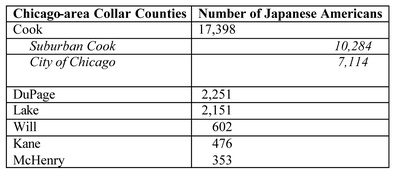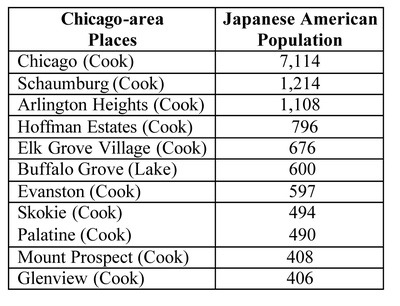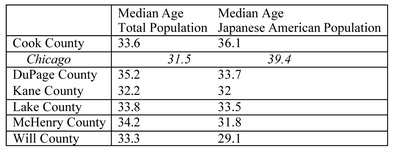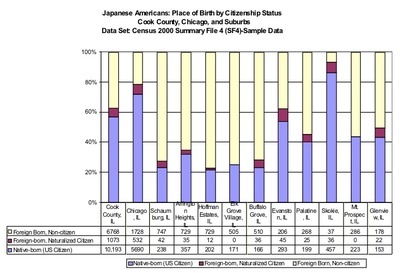Compared with the West, South, or Northeast regions in the US, the Midwest region has both the smallest Asian American population and the smallest Japanese American population. However, nationally Illinois has the sixth largest Japanese Americans population (27,702 individuals) and is the top state within the Midwest.
Census 2000 was the first to collect "racial" data that allows for multiethnic and multiracial self-identification with the instruction, "Mark one or more races to indicate what this person considers himself/herself to be." As seen in Figure 1, we now have a more complete picture of the evolving Japanese American community. Each two-part bar shows the "Japanese in combination with one or more other races and/or detailed Asian groups" (top portion) and the "Japanese alone" group (bottom portion) by 10 year age-ranges in Illinois. For example, among 0-9 year olds, 2,195 are "Japanese in combination" and 1,956 are "Japanese alone." Added together, there are 4,151 Japanese alone or in any combination in the youngest age range. This inclusive definition will be used in the remainder of the report.
Figure 1
GEOGRAPHIC DISTRIBUTION
As might be expected, the vast majority (85%) of Illinois' nearly 28,000 Japanese Americans lives near Chicago in the following counties: Cook (includes Chicago), DuPage, Kane, Lake, McHenry, and Will. (See map below)
Table 1: Japanese American Population in Chicago-area Collar Counties in Illinois
Within Cook County, about 40% of all Japanese Americans live in Chicago. Within Illinois, only one quarter of all Japanese Americans live in Chicago. Now most Japanese Americans in Illinois live in the suburbs.
Table 2 presents in rank order the eleven places with the largest Japanese American populations in the six-county region. Cook County suburbs predominate.
Table 2: Top Eleven Chicago-area Japanese American Places
GENDER DISTRIBUTION
The number of Japanese American males and females is roughly equal in Chicago and the area counties as is shown below. (Table 3)
Table 3: Japanese American Population in Chicago-area Collar Counties by Gender
MEDIAN AGE
At the county level, Japanese Americans are generally the same age as others in the area (Table 4). However, Chicago Japanese Americans (median age of 39.4 years) are quite a bit older than other Chicagoans (median age of 31.5 years). Chicagoans who are "Japanese Alone" are, on average, 44.6 years old—a full 13 years older than other city residents! This suggests that many Chicago resident Japanese Americans are elderly.
Table 4: Median Age by Chicago-area Collar Counties for Total Population and Japanese American Population
Japanese Americans in Cook County and Chicago
Because most Illinois Japanese Americans live in Chicago and its suburbs, the remainder of this report concentrates on these regions. Census 2000 tabulations provide detailed information on social, economic, and housing characteristics from the "long form" census sent to one in every six households and tabulated in Census 2000 Summary File 4 (SF4)-Sample Data.
MARITAL STATUS
Over half (58%) of all Japanese Americans aged 15 or older in Cook County are married, about one third (32%) have never married, and 10% each are widowed or divorced. In Chicago, about 45% are married, about 42% have never married, and about 6.5% each are widowed or divorced.
NATIVITY
The foreign born make up about 43% of all Japanese Americans in Cook County and over one fourth (28%) in Chicago. (See Figure 2) Despite the large percentages of foreign born, naturalization rates are relatively low. In Cook County, about 14% of foreign-born Japanese Americans are naturalized citizens; in Chicago nearly one quarter (24%) are naturalized citizens.
Figure 2
The suburbs where Japanese Americans reside are a study in contrasts. (Figure 2) At one extreme, Skokie can be characterized as a primarily US native-born Japanese American suburb. At the other end, Hoffman Estates, Elk Grove Village, Buffalo Grove, and Schaumburg are primarily foreign-born Japanese American suburbs. However, in all places the number of foreign-born naturalized citizens is very low.
FOREIGN-BORN JAPANESE AMERICANS
By far, the vast majority of foreign-born Japanese Americans in the Chicago area are recent immigrants who arrived between 1990 and 2000. (Table 5) In Cook County, nearly two-thirds (63%) of all foreign-born Japanese Americans arrived in the decade of the '90s. In the city, over half (52%) of all foreign-born Japanese Americans arrived in the same time period. Furthermore, during all time periods and in all places, the number of foreign-born Japanese American females exceeds that of males.
Table 5: Japanese American Foreign Born by Year of Entry by Gender for Chicago-area Collar Counties
The settlement of foreign-born Japanese Americans reveals a striking pattern seen especially clearly by comparing Chicago and suburban Cook County. (Figure 3) The earliest immigrants, those who arrived before 1965, show no strong preference for the suburbs over the city. Later immigrants more often reside in suburban Cook County. And the most recent immigrants overwhelmingly prefer the suburbs to the city.
Figure 3
LANGUAGE PROFILE
Despite the large percentages of American-born Japanese Americans (57% in Cook County; 72% in Chicago), linguistic isolation (i.e. the individual speaks a language other than English and speaks English less than "very well") is a problem in our community. In Cook County, nearly one third (32%) of all Japanese Americans aged 5 and older are linguistically isolated; in Chicago, about one fifth (21%) are linguistically isolated.
The following figure (Figure 4) shows the percentage of "English Only" and "Linguistically Isolated" Japanese Americans. "Bilingual" is a residual category—i.e. the difference between the total Japanese American population for that locale minus the sum of ("English Only" + "Linguistically Isolated").
Figure 4

Figure 4: Japanese Americans; Language Profile in Cook County, Chicago, and Suburbs. Click to enlarge.
Language profile data mirrors the nativity data. That is, in a primarily American-born suburb such as Skokie, about 70% of the Japanese American population speaks only English. By contrast, in Schaumburg, a predominantly foreign-born Japanese American suburb, nearly 70% of the Japanese American population is "linguistically isolated" and presumably Japanese speaking. Clearly, for a significant proportion of Japanese Americans, Japanese is the language of choice. Even in the Midwest, there is a need for linguistically appropriate social services, an ethnic press, and Japanese language TV.
EDUCATION
In both Cook County and Chicago, Japanese Americans aged 25 and older are very well educated. A mere 5% have less than a high school diploma and nearly half (48.4% in Cook County; 46.5% in Chicago) have a graduate or professional degree. Elderly Japanese Americans are a similarly well-educated cohort. Only 4% of all Japanese American seniors in Cook County and Chicago have less than a 9th grade education and almost one quarter (23% and 22% respectively) have a bachelor's degree or higher.
EMPLOYMENT STATUS, OCCUPATION, AND INDUSTRY
Well over half of all Japanese Americans aged 16 and over in Cook County (58%) and Chicago (55%) are employed. For Japanese American women aged 16 and over, this rate falls slightly in Cook County (48%) and Chicago (50%). High labor force participation rates also characterize families with small children under 6 years old. In those Japanese American families with young children in Cook County, both parents work in about one third (35%) of all households. In Chicago, this figure rises to nearly half (49%).
By and large, Japanese Americans in Cook County and Chicago hold managerial, professional and related occupations (56% and 53% respectively) or sales and office positions (29% and 31%). These occupations suggest that Japanese Americans hold jobs commensurate with their high levels of education.
The top five industries for Japanese Americans in Cook County are: education, health, and social service (20%), professional, scientific management, administrative and waste management services (15%), manufacturing (13%), wholesale trade (10%), and retail trade (9%). In Chicago, the industry mix and percentages differ slightly with education, health and social service at 20%, professional, scientific, management, administrative and waste management at 19%, followed by retail trade at 11%, finance, insurance, real estate, and rental and leasing at 9%, and manufacturing at 8%.
INCOME
Median household income in the most populous Chicago-area Japanese American places generally shows that the ethnic households earn the same as or more than the general population. (Figure 5) This trend holds true in every place except Evanston. The lower incomes in Evanston may reflect Japanese American student households in this college town.
Figure 5

Figure 5: Median Household Income in 1999 Dollars in Top 10 Illinois Places for All Households and Japanese American Households. Click to enlarge.
POVERTY
Despite perceptions that all Japanese Americans are well off, we too experience poverty. In Illinois, about 11% of the total population is poor; for Japanese Americans, this rate is 8%. In Chicago, nearly 20% of the total population has an income below the 1999 poverty level while 12% of all Japanese Americans living in the city are poor.
The following figure (Figure 6) shows poverty status for all Japanese Americans in Chicago, that is, it shows the number with incomes below poverty and those at or above poverty. Among the roughly one thousand (946) Chicago Japanese Americans with incomes below poverty, about 12% are children, under 18; 72% are adults, aged 18-64; and 12% are elderly, age 65 and over.
Figure 6
HOUSING TENURE
The percentage of Japanese American owner-occupied housing units in Chicago and Cook County were generally comparable to the general public. In Chicago, 45% of Japanese American housing units were owner-occupied; for the general population in the city it was 44%. In Cook County, the Japanese American rate was 46% compared to 57% for the total county population.
There are, however, much lower rates of homeownership among Japanese Americans in suburban Chicago compared with the general public in the same places. (Table 6) At first glance, this is surprising because median household incomes for Japanese Americans equal or exceed their neighbors. (See Figure 4) However, while homeownership makes sense for US citizen Japanese Americans, renting probably makes more sense for foreign-born, non-citizens who are here temporarily on work postings but plan to return to Japan.
Table 6: Housing Tenure: Percent Distribution of Owner-Occupied Housing Units for Japanese Americans and the General Public in Ten Chicago Suburbs
Conclusion
This snapshot of Chicago's Japanese American population presents a demographic overview of our community. But beyond this socio-economic portrait is Chicago's Japanese American community in the flesh. Our community is bounded not by geography but by social ties, long standing institutions, and a shared history. Our assets include still active organizations founded decades ago such as the Japanese Mutual Aid Society of Chicago established in 1934; Japanese American Citizens League, Chicago Chapter founded in 1944; an ethnic newspaper called the Chicago Shimpo which celebrated its 60th anniversary in 2005; the Japanese American Service Committee (formerly called the Resettlers Committee) founded in 1946 to help with resettlement of Japanese American from America’s concentration camps; local Japanese American Christian churches and Buddhist temples formed in the 1940s; and the Chicago Nisei Post No. 1183 American Legion (originally named Rome Arno Post) established in 1949.
Thousands of Nisei and Sansei have fond memories of the Chicago Nisei Athletic Association (CNAA), a grass roots sports association started in 1946 as a vehicle for community formation among those recent arrivals to Chicago from the internment camps. In the late 1950s, Nisei athlete parents reinvigorated the CNAA for their Sansei children. The CNAA was an active force in the Chicago Japanese American community through the late 1980s. Its history was documented by our historical society and resulted in a traveling exhibit on display at the Chicago Historical Society in 2003.
Though it had a shorter life span and fewer participants, the Nisei Ambassadors Drum and Bugle Corps, Inc. founded in 1959 by the Nisei Post was a prominent community institution in the 1960s and early 1970s. What sets this group apart from other local organizations is its proud racial diversity. During the 1960s, few Japanese American based organizations anywhere were made up of Asians, Whites, and Blacks. The corps was highly ranked in Midwest and national tournaments but disbanded in the early 1970s as the bulk of Sansei left for college or "aged out" from participating in drum and bugle corps events.
On a smaller scale or more informal basis, golf groups, bowling leagues, investment clubs and social clubs flourished from the mid-1940s through the 1990s. Japanese language classes, martial arts, koto, shamisen, ikebana, chanoyu, classical and folk dance are among the traditional elements of Chicago's Japanese American community. Now, taiko groups and classes draw younger Japanese Americans while the Na Kapuna Ukulele Club attracts many Nisei.
Festivals and community events are other markers of the community's assets. These include some long standing events such as the Japanese Mutual Aid Society sponsored annual Memorial Day Service held at Montrose Cemetery, Natsu Matsuri (Buddhist Temple of Chicago), the Ginza Festival (Midwest Buddhist Temple), or Holiday Delight/Kodomo Matsuri (Japanese American Service Committee). Obon is celebrated at the Midwest Buddhist Temple in Chicago and at Mitsuwa Marketplace in Arlington Heights. Japan Day is celebrated annually at the Chicago Botanic Garden and the sister city relationship of Osaka and Chicago is feted at the Osaka Garden Festival. Day of Remembrance programs sponsored jointly by the Chicago Japanese American Historical Society (CJAHS), the Japanese American Service Committee (JASC) and the Japanese American Citizens League (JACL) Chicago Chapter are an annual occurrence. In the mid-1990s, Sansei successfully revived the community picnic which is now co-sponsored by the JASC, JACL, Japan America Society of Chicago, the Tohkan Judo Academy, and Asian American Law Enforcement.
While Census 2000 allows analysis that highlights increasing racial and ethnic diversity, geographic dispersal, and contrasts between native-born and foreign-born Japanese Americans, a qualitative portrait of the community's assets in its institutions, organizations, and events reflects the continued vitality of Chicago's Japanese American community.
* This article was originally publised in the Voices of Chicago by the Chicago Japanese American Historical Society.
© 2005 Chicago Japanese American Historical Society



